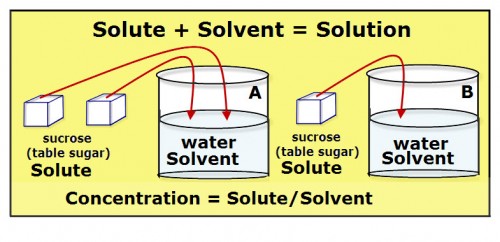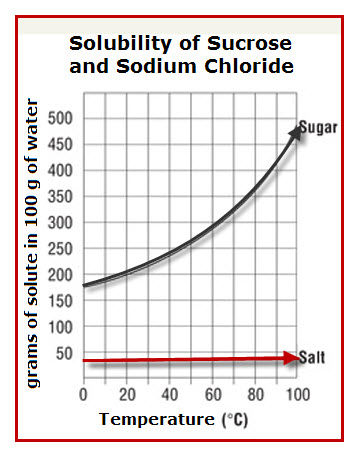What is a Solution? How do You Saturated A Solution?

A solution is a homogeneous mixture, meaning it is the same throughout. A solution can be made of more than two substance, with one of the substances being the solvent and the substances that dissolve in the solvent are called solutes.
You make and use chemical solutions every day. Add sugar to your cereal or tea and you have made a solution. Put on any cologne or perfume and you are using a solution. While the examples on this page use water as the solvent, there are many different kinds of solvents–ethyl alcohol is the solvent in colognes and perfumes.
How Does A Solution Form?
A solution forms when a solute dissolves in a solvent, which means the solute breaks apart and disperses equally throughout the solvent. Adding sugar to water is an example of making a solution because the sugar (solute) will dissolve in the water (solvent).
The concentration of a solution depends on the ratio of the amount of solute to the amount of solvent. If the amount of solvent remains constant, then the concentration of the solution is a function of the solute. This means that any change in the amount of solute affects the solutions concentration.This could be expressed as:
C(solute) = amount of solute/ amount of solvent
Read as: A Solution’s concentration as a function of solute is the ratio of amount of solute to amount of solvent.
Dilute refers to a low concentration. Dilute is not a quantitative term, instead it is more qualitative, meaning descriptive. Dilute refers to having a small amount of solute in a large amount of solvent. Small and large are also descriptive terms. How small? How large? My point is that saying a solution is dilute doesn’t give enough information unless you are comparing it to something else. For example, if you prepare two solutions as shown in the diagram. You could say that solution-A is more dilute than is solution-B.
Other qualitative descriptions for solution concentration include saturated solution and super saturated.

A saturated solution is made by dissolving as much solute as possible in a solute. For example, add table sugar (solute) to a glass of water (solvent) until no more sugar will dissolve even with vigorous stirring. The undissolved sugar settles to the bottom of the glass. The amount of sugar that dissolves depends basically on the amount of water and its temperature.
Look at the Solubility Graph for Sucrose and Sodium Chloride. The dark line representing the solubility of sucrose – sugar at different temperatures curves upward. The red line representing the solubility of salt-sodium chloride only slightly rises. Thus, while an increase in temperature greatly affects the amount of sugar that will dissolve in water, there is very little affect on the solubility of salt.
A supersaturated solution of sugar could be formed by heating the solution to the boiling point of water, which is 1000 C. The solubility graph shows that at this temperature, about 475 g of sugar will dissolve in 100 g of water. When all the sugar has dissolved, the solution is allowed to cool. At any temperature lower than 1000 C, the solution is considered supersaturated. This is because the solution has more solute dissolved in the solvent than normally dissolves at the lower temperature.
Big Book of Science Experiments
A book of fun informative experiments about astronomy, biology, chemistry, earth science, and physics.
(Paid Link)
